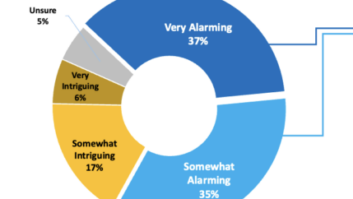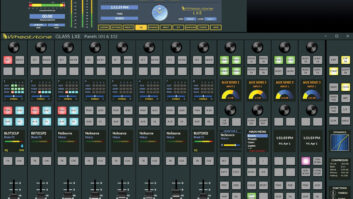
I probably am not the first person to call when it comes to any and all things Mac. I spend my days cranking out nationally syndicated talk radio programming on Windows and Linux machines, using the software with which I am most familiar. We have several iMacs at the network that we use for video editing, but I don’t spend much time near them.
When I was offered to try out the Apogee Electronics MiC 96k professional digital microphone, I knew the company made audio hardware exclusively for Apple products. But I asked anyway: “Does it work on any computer?” and they told me, “We designed it for Mac hardware.”
O-okay-y … send it anyway.
A STEAL
I figured this was a good opportunity for me to get on good terms with Mac hardware and software and to see what I can get the MiC to do when I’m removed from my comfort zone. Going in without any notions or prejudices, I was bound to be impartial. Hard to imagine, given the experiences I have had with USB microphones from many other companies: low levels, noisy preamps, gritty A/D converters and low threshold for overload and distortion. Besides, there were plenty of people at work with iPhones that I could convince to plug in and try out the MiC on their own, then harvest their opinions.
Here’s the quick read: If you are in radio and you have a Mac computer, iPad or iPhone, get one of these now.
The fact Apogee Electronics was behind the design of the MiC is enough to go get the checkbook. I had hoped for the same in the MiC. The unit they sent me to try out is the 96k model, which can output a 24-bit/96 kHz signal. Add to that a responsive and detailed condenser capsule, and the street price of about $230 becomes a steal.
The MiC has the looks and lines of any classic condenser microphone you have seen in your career, only in a stubby little 4.5-inch long body. Its zinc diecast body packs some surprising heft for its size, and that 3/4-inch condenser capsule is mounted inside a double layer of nice stiff screening.
I’m pretty certain the Apogee engineers knew the MiC was not going to be a coddled condenser mic that would be lovingly returned to its velvet bag and back into its lacquered walnut case every evening after a session, but stuffed randomly into the accessory pocket of a MacBook bag after an inspired impromptu recording, likely somewhere unusual. They built it to boogie.
Given that, I did notice the finish they gave the case is a bit prone to scratching. One of our staff missed when trying to plug into the output socket and left a long divot in the end cap.

The mic is supported by a clever little tripod accessory with a standard 1/4-20 thread as used on cameras. Apogee also included an adapter that couples the MiC to a standard mic boom thread. Brownie points for not making us shop for an accessory that should be included.
Seeing how Apogee Electronics decided what went inside, I knew the preamp was going to be ultraquiet and the converter was going to be miles ahead of your basic epoxy blob. The company did more than that: they included a gain control on the mic body to dial in your recording level (rather than opening a mixer window on your hardware), and a tricolor LED on the mic body that tells you if you’re connected (blue), if you’re talking to your software (green), and if you’re talking too loud (red).
Apogee packed the mic with good ole USB cabling, but also included Apple’s proprietary eight-pin Lightning connector, as well as a cable for the earlier 30-pin version of Apple sockets. You are covered, no matter how you hook up to your Mac product.
TESTING 1-2-3
The first test recording we made was a tabletop setup: MiC on its tripod and plugged into an iPhone, recording a voiceover to be emailed to our production room.
Those of us present were surprised by how quiet the mic was — like I said, we have had experience before with digital mics and USB interfaces and had been less than impressed. But on the MiC, we had a clean, noiseless recording with lots of clarity. When no one spoke and only room atmo was evident, there was none of the graininess or fizziness we have heard in those aforementioned USB mics. The Apogee MiC 96k proved its worth right out of the gate.
What was noticeable was a bit of phasing honk — the mic was too close to the tabletop and picking up the reflected voice of our performer. Done a second time with a jacket under the tripod fixed everything.
Our second recording was done on a small boom to avoid the tabletop reflection, directly into Garage Band on one of our iMac video editors. Here we had greater control over processing (EQ, compression etc.). Same result: wonderfully accurate and airy tracks that we could further process into Billy Big Voice for the radio.
One last recording was a two-person interview sitting close together in a V-pattern in front of the mic. The big concern was that the cardioid pattern would be too tight to cleanly capture both of our participants without getting an off-axis sound and some roominess. But the pattern is somewhat generous and we did fine.
It is worth mentioning that, directly on-axis, the MiC is prone to plosives, as are nearly all condenser mics. Good practice dictates angling the microphone or using a pop filter. No doubt you already own one.
We did not attempt to record anything at the highest resolution settings, since our end users are affiliate radio stations, and the FM affiliates wouldn’t reproduce much above 15 kHz anyway. Still, it’s nice to know it’s there when it’s time for a critical recording.
Product Capsule
Apogee Electronics
MiC 96k
Thumbs Up
+ Apogee guts inside, hard shell outside
+ Affordable
+ Up to 96 kHz sample rate
+ Cables, stand and adapter are standard accessories
Thumbs Halfway
~ Exclusively for modern Mac hardware, but tests indicate it could work with Win or Lin machines
Thumbs Down
– Finish may scratch under moderate use
Price: $229
For information, contact Apogee Electronics in California at (310) 584-9394 or visit www.apogeedigital.com.
Apogee Electronics is positioning the MiC 96k for musicians, voiceover folks and multimedia creators; all you need to do is check out the company website and see the demonstration videos. But I am finding the MiC to be a valuable addition to the arsenal of any broadcaster using Mac products.
Yes, we can record the mayor at a news conference via phone and send it back to the studio, but those recordings are thin and indistinct. Get a MiC up-front and get the best recording in the house.
Voicetracking jocks can simplify their rigs by using just a MiC and a Mac laptop at home, then switch gears and cut tracks in Pro Tools for agency ads, all on the same laptop.
And that band that can’t meet you at the studio for the morning show? Hit their hotel room and grab an impromptu acoustic performance, without sounding like its being recorded with a 1980s vintage dynamic mic into a Uher.
I’ve discovered a bit about Mac hardware this time out, and how to make one sound really good with an Apogee MiC. And for what it’s worth, I got it to work on my clunky old Windows XP machine. But this is one for the Apple crowd. I definitely recommend this mic: It is inexpensive, durable, and it sounds really good. Plus, it’s American-made by Apogee Electronics, and that says plenty.
Alan Peterson has been the production director at the Radio America Network, Arlington Va., for ten years, and is a familiar name to long-time RW readers. He can be reached at [email protected].












